
 |
Kathmandu, page 3 of 4 |
Today we go to visit famous temples outside
Kathmandu. We start with a walk to Swayambhunath, also called the ‘monkey
temple’ because of all monkeys that play around on the big stairs that
lead towards the temple. It is a Bhuddistic Stupa. A Stupa is a religious symbol;
a kind of representation of earth and heaven, the center represents 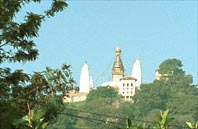 the
spindle around which the earth turns. On the top of the Stupa you see a pair
of eyes, this are the eyes of Buddha who is watching you. We think of course
immediately of Orwell's 1984 and Big Brother Is Watching You, but Buddha means
it in a quite friendly and harmless way, don’t worry! The nose looks like
a questions mark, the Nepali number one and a symbol of unity. The dot between
the eyes is the third eye, symbol of the clairvoyant powers of Buddha.
the
spindle around which the earth turns. On the top of the Stupa you see a pair
of eyes, this are the eyes of Buddha who is watching you. We think of course
immediately of Orwell's 1984 and Big Brother Is Watching You, but Buddha means
it in a quite friendly and harmless way, don’t worry! The nose looks like
a questions mark, the Nepali number one and a symbol of unity. The dot between
the eyes is the third eye, symbol of the clairvoyant powers of Buddha.
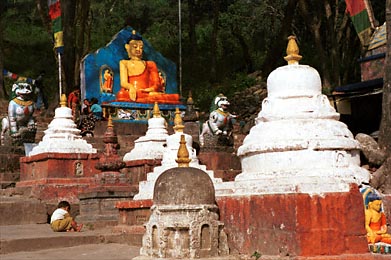
I won’t go into more details about the Stupa
and Buddhism; you can read it in any guidebook or encyclopedia. Maybe I have to add that
Buddhism is a very free believe, there are no specific gods and they don’t use the
Hindu castes  system.
Gompa’s, the monasteries of the Bhuddistic monks are scattered around the Stupa. Like
the Hindi they use a lot of colors, but Bhuddists here use white for the Stupa, gold for
bells and especially primary contrasting colors like red, yellow, blue, orange, for
everything around the Stupa and for all the garlands with flags that are hanging
everywhere. The statues and also the white Stupa are painted regularly to keep the colors
fresh and shining.
system.
Gompa’s, the monasteries of the Bhuddistic monks are scattered around the Stupa. Like
the Hindi they use a lot of colors, but Bhuddists here use white for the Stupa, gold for
bells and especially primary contrasting colors like red, yellow, blue, orange, for
everything around the Stupa and for all the garlands with flags that are hanging
everywhere. The statues and also the white Stupa are painted regularly to keep the colors
fresh and shining.
The Stupa of Swayambhunath is close to Kathmandu,
on a small hill to the west. It was quite a climb, first through the small village and
than up an endless flight of stairs. But our destination was very clear: from far away
already we saw the top of the Stupa just above the trees. Next to the stairs are a lot of
statues of animals (vehicles of the Dhyani Buddha's), so if you are exhausted you can just
pretend to be very interested in this pair of peacocks or that pair of elephants… But
you can’t stay too long on the same place, because then you start to attract the
attention of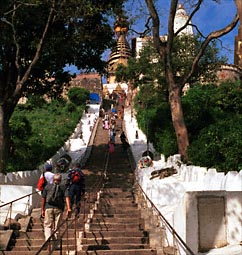 either beggars or people who sell
souvenirs. We see monkeys playing on the stairs, one of them glides down sitting on the
double barrister, he gathers a lot of speed and jumps exactly timed over the pairs of
knobs that extent each ten meters from the barrister. Jacques looks a little worried when
he sees how dangerous this is to the more delicate manly parts of the monkey…
either beggars or people who sell
souvenirs. We see monkeys playing on the stairs, one of them glides down sitting on the
double barrister, he gathers a lot of speed and jumps exactly timed over the pairs of
knobs that extent each ten meters from the barrister. Jacques looks a little worried when
he sees how dangerous this is to the more delicate manly parts of the monkey…
We walk round the Stupa, clockwise as you have
to, go with the sun or something like that? It is lucky people in India and Nepal keep to
the left, otherwise they would be sure to make mistakes with this rule. Behind the
enormous Stupa are a lot of small black mini Stupa’s, they look like big
chess-pieces, abandoned on the board somewhere in the middle of the game. Around the Stupa
are a lot of 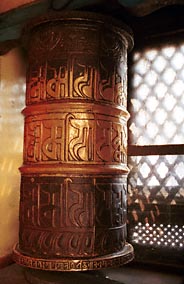 prayer
wheels, while you are walking around the Stupa you let them spin around one after the
other with your hand, thereby releasing the mantra that is imprinted on the wheel. An
efficient way of praying! All the flags provide an even more efficient way of praying:
they pray for you while they are moving in the wind! In one of the monasteries around we
saw a very big (1.5 meter high) prayer wheel, see the picture on the left!
prayer
wheels, while you are walking around the Stupa you let them spin around one after the
other with your hand, thereby releasing the mantra that is imprinted on the wheel. An
efficient way of praying! All the flags provide an even more efficient way of praying:
they pray for you while they are moving in the wind! In one of the monasteries around we
saw a very big (1.5 meter high) prayer wheel, see the picture on the left!
We follow the stairs down again; this is a little easier than up! At the bottom of the stairs we find an auto-riksja that wants to bring us for a reasonable price to Pashupatinath, to the east of Kathmandu. This auto-riksja has some problems, the chauffeur uses a rope to open and close the gas inlet directly at the motor, the gas handle is broken. A bit difficult to manage, but from his experienced moves I guess that he has done this before… Except this small problem, the power of the motor of the riksja seems to be very limited. It has difficulties with slopes, any time we have to take a steep slope I worry if we have to start pushing! This doesn’t happen, each time I’m surprised again that this old riksja’s keep driving, some are more than 10 or even 15 years old and you can smell that!
 In Pashupatinath we walk towards the holy Bagmati River, where the famous
Pashupatinath temple is located - for pictures see the next page. This temple is the most
important holy place of the Hindu people in Nepal. It is dedicated to Shiva, and not only
from Nepal, but also from India many Hindi come to Pashupatinath to pay their honors to
Shiva. Of course a lot of Sadhus are present everywhere you look, with and without flute
and snakes to amuse tourists. Non-Hindu (or in fact non-Eastern looking people)
aren’t allowed in this famous temple.
In Pashupatinath we walk towards the holy Bagmati River, where the famous
Pashupatinath temple is located - for pictures see the next page. This temple is the most
important holy place of the Hindu people in Nepal. It is dedicated to Shiva, and not only
from Nepal, but also from India many Hindi come to Pashupatinath to pay their honors to
Shiva. Of course a lot of Sadhus are present everywhere you look, with and without flute
and snakes to amuse tourists. Non-Hindu (or in fact non-Eastern looking people)
aren’t allowed in this famous temple.
We take a seat between small Stupas on the other
side of the river, from where you can try to look inside the temple court, which is almost
impossible because large, not very beautiful buildings surround it. A Sadhu is sitting
next to us and I must say it was one of the strangest creatures I ever saw. A very thin
man 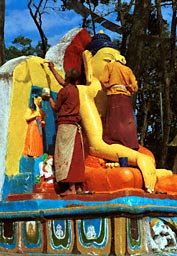 with long dark hair twisted in long locks
that stood stiff with dirt perpendicular on his head in all directions, brown naked feet
full of dust, his face covered with oranges stripes, clothed in yellow and orange rags, an
impressive wooden staff in his hand. He looked at us with frightening eyes that made me
unsure if he happened to be on the point of definitely loosing his sanity or if it amused
him to shock ridiculous tourists.
with long dark hair twisted in long locks
that stood stiff with dirt perpendicular on his head in all directions, brown naked feet
full of dust, his face covered with oranges stripes, clothed in yellow and orange rags, an
impressive wooden staff in his hand. He looked at us with frightening eyes that made me
unsure if he happened to be on the point of definitely loosing his sanity or if it amused
him to shock ridiculous tourists.
Totally ignoring this Sadhu, who appeared at least sane enough to ask an incredible amount of money when some tourists wanted to make pictures of him (and they even paid it, so much for sanity!), we watch the river, the golden roof of the temple, we hear a lot of bells ringing (brings luck as we learned in Varanasi), see the water flowing by and smell the penetrating stench of burning dead bodies.